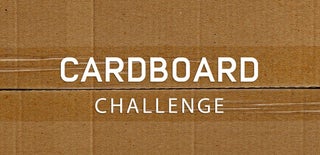Introduction: Steampunk Dragon Head With Cardboard
Hey Ya'll!!
In this Instructable, I'll be showing you how to make a Steampunk Dragon head mount.
When I first started making this, I honestly had no idea where I was going with it. I had a basic idea in my head, but other than that, it was a lot of making it up as I went! Hopefully though, you will be able to follow my steps to save you time and give you some ideas on how to make your OWN steampunk dragon! :P
This dragon is actually super easy to make! The base is 100% cardboard and hot glue and the skin is made of faux leather!
The most important thing is to LOOK AT THE PICTURES! I try my best to explain the steps in words, but pictures explain the steps much better than I can!
Step 1: Supplies
The supplies needed for the dragon are:
- Cardboard - The entire dragon is made from cardboard and the majority of it is from a single Goldfish Box.
- Faux Leather - I bought a fake leather jacket from Goodwill for $5 but if you don't have a jacket to use, most craft stores supply fake leather.
- Black Fabric - I used the inside of the leather jacket, but any sheer fabric will work.
- Hot Glue Gun
- Super Glue
- Rub-n-Buff - found at most craft stores
- Old, rusty nails
- Craft nails (approx. 6 mm)
- 1/2 inch Copper Tubing connectors
- 1/8'' x 3/8'' rivets
- Copper Tarp Grommets
- Old Chess Pieces
- Craft Wire (22 gauge)
- Wire Snippers
- Needle Nose Pliers
- A collection of assorted junk jewelry, beads, steampunk charms ect. Basically anything to decorate the dragon.
In the photos, I've included the approx. patter for the dragon head. I traced them onto paper for you to use if you'd like but they are not necessary. You can make whatever pattern you'd like for your dragon.
Step 2: Brainstorming and Cutting
I toyed with the idea of a moving jaw, but for now, this being my first dragon head, I decided to make it all one solid piece. I sketched out a few ideas just to get a feel for what I was creating.
Start with tracing and cutting out the dragon's skull and jaw from the Goldfish box.
Trace each shape of the dragon head from your paper to the cardboard and cut them out. (See photos)
Make sure they are symmetrical!
You will need two of each part of the skull and jaw as shown in the photos above.
Step 3: Forming the Mouth
The head is made of two parts, the skull (the top half) and the jaw (lower half).
Connect the two skull halves with a thin strip of cardboard. It should be about 1/2 inches wide.
Connect the two jaw halves with a slightly thinner piece of cardboard. Once it is connected, be sure it fits INSIDE the upper jaw smoothly so it could, theoretically, move back and forth. It will be glued together in a later step, but needs to be inside the skull.
Step 4: Giving the Skull Shape
The dragon can't have flat sides to his head or he would look unrealistic.
Most dragons (and dinosaurs) Have slightly concave eyes but the jawline protrudes.
Using small scraps of cardboard and round pieces, stack and glue them onto your dragon's skull and jaw wherever you want contrast and dimensions.
The main accents should be around the jawline and mandible, above the eyes, and snout. The more cardboard to give him some shape, the better. At this point, I placed the lower jaw inside the upper jaw temporarily but didn't glue it in place. This gives me an idea of what the dragon looks like, but its still movable and easy to work around.
Step 5: "Paper Mache"
Cut scraps paper into pieces approx. 1 in. x 2 in.
Begin gluing them onto the dragon's skull and jaws. They should completely cover the cardboard. This will help smooth out any hard edges created by the cardboard. Although your dragon will look like a low-budget mummy, trust me, this step is important! ;)
Step 6: Starting to Add the Skin
Rub-n-Buff is perfect for getting a metallic finish to the faux leather. It gives the leather a dragon skin appearance. But, if you use too much, it can become overkill quickly. Start with a small drop on a paper towel and rub it across the leather. It dries almost instantly, so rub it in quickly.
A mix of both the gold, silver, and black faux leather jacket create a perfect shade of slightly shiny dragon skin. (Of course, I've never seen real dragon skin, so I'm only imagining that this is a semi-accurate color.)
Once the desired shade of skin is reached, begin cutting it out and gluing it onto the paper-covered dragon head.
Be sure that when hot-gluing it on, do not let it overlap itself or the skin will not lay flat. Cover both the skull and jaw with skin. Do not cover the inside of the mouth, however.
Step 7: The Neck and Finishing the Skin
I did not include the measurements of the neck simply because there are no exact shapes I used. In the photos, you can see that I cut out 6 triangles/trapezoids all from the same strip of cardboard, and these formed most of the neck. It was a lot of eyeballing and overall, pretty simple.
Glue the neck together and onto the back of the dragon's head. Finish by gluing skin over of the neck and tucking it into the back of the neck. At this point, glue the jaw and skull together, too.
Now, the skin should be complete and cover the entire head and neck
Step 8: Eyes, Nose, and Frill
The nostrils are two pieces of the scrap leather folded into themselves and glued into place. They resemble two teardrops and get placed at the tip of the snout.
Glue a triangular piece of leather over top of them so they appear connected to the head.
Next, the frills of the dragon are made with old rusty nails and the lining of the leather jacket. I suppose you can use any type of fabric you want, and the nails don't necessarily need to be old and rusty, but it adds a lot of character to the dragon if they are!
Glue the heads of 4 nails together. They should be at approx. 0,60,120, and 180 degrees. Reference the photos for this step. Next, trace the black fabric (again, I used the lining of the leather jacket) around the nails, cut it out, and glue it to the them. If you want to add a little Rub-n-Buff to shine them up, its a nice effect. ;)
Do this step twice so you have two frills, one for each side of the head.
Last, cut out a small scrap of leather, about 1" long and fold it over, hot-dog style. Glue it right above where the eye will be, sort of like an eyebrow or how the skull protrudes above the eyeball. (sorry, I'm not up to date with all my dragon anatomy!)
Step 9: The Tarp Grommet Horns
I have to admit, I'm pretty proud of myself for coming up with this part. lol
The way Tarp Grommets are supposed to be used, there is a tall piece (like a top hat) and a short piece (like a record). For the horns, only use the tall pieces.
Since they are metal, you will need to break out your super glue, or if you are REALLY crafty, some sort of solder. I used super glue, and it worked just fine.
The grommets stack on each other quite nicely, but when you glue them, you will want to tilt some of them at slight angles so the finished horn isn't perfectly strait, but rather curves and bends. Each horn is about 4 inches long, but you can make them however long you want.
To cap them off, bend two grommets at the tips (see photos). Glue these at the top of the horns.
Step 10: Attaching Frills and Horns
Super glue the frills on each side of the dragon's jawline and the horns to the top of the skull.
If you want, you can cut a scrap of leather and wrap it around the horns. This gives it a smoother appearance and makes them look like they are growing out of the skull. I did that with one horn, but not the other. Since it is an steampunk dragon, I wasn't too worried about symmetry.
Step 11: The Eyes and Decorations!
This is the best part!! :D
But its also the part where I'm not going to show every step. Its all pretty self explanatory at this point, because all I am doing is attaching charms, wires, and rivets and such to the head. If I were to explain every step it would simply be showing you the order in which I glued on the decorations. And ain't nobody got time for that!
You can copy the decorations I did, or you can do your own. Since I know we won't have the same materials and charms, get creative, and really make your dragon your own!
The one part I will explain is the eye. I used two 1/2 inch metal marbles and glued them into the socket. Then I cut two pieces of leather in the shape of two "C"s, and hemmed them with glue. These were the top and bottom eyelids of the dragon. I covered the connection with a spider charm, but any charm will work.
The main supplies I used were:
- 1" rivets under the eyes
- Chess pieces rubbed with Rub-n-Buff on the sides of the mouth and head
- Old Circuit Boards on the back of the head.
- Wire sticking off the back
- Old, uncurled, watch springs that attached by the neck
- Charms, old jewelry, gears
Step 12: Spikes, Teeth, Backing
LAST STEP!! WOO HOOO!!
The teeth and spikes are made from small craft nails. They were found in our Grandfather's tool chest, and very rusty. Perfect.
When you super glue the nails for the teeth, make them uneven and with no order. They should be messy and pointy and dangerous. A dragon's teeth aren't going to look like he just got his braces off, they are crooked and some are missing.
Glue a few spikes on the eyelid and optionally, along the ridge of the snout.
Cut out a piece of thick cardboard for the baseboard and cover it with the black fabric from the jacket's lining. Hot glue the dragon's neck to the cardboard and secure with super glue.
I used the flat half of a Grommet for the backing. By bending it with pliers and gluing it to the back, it forms a perfect hook.
Step 13: Finished!
Overall, the dragon turned out so much better than I imagined! If you decide to make your own, please please PLEASE post pictures! I'd love to see it!
If you have any advice, please let me know, and please consider voting for my dragon in the Cardboard Contest. It'd mean so much.
As always,
Elsie B.

Participated in the
Cardboard Challenge













